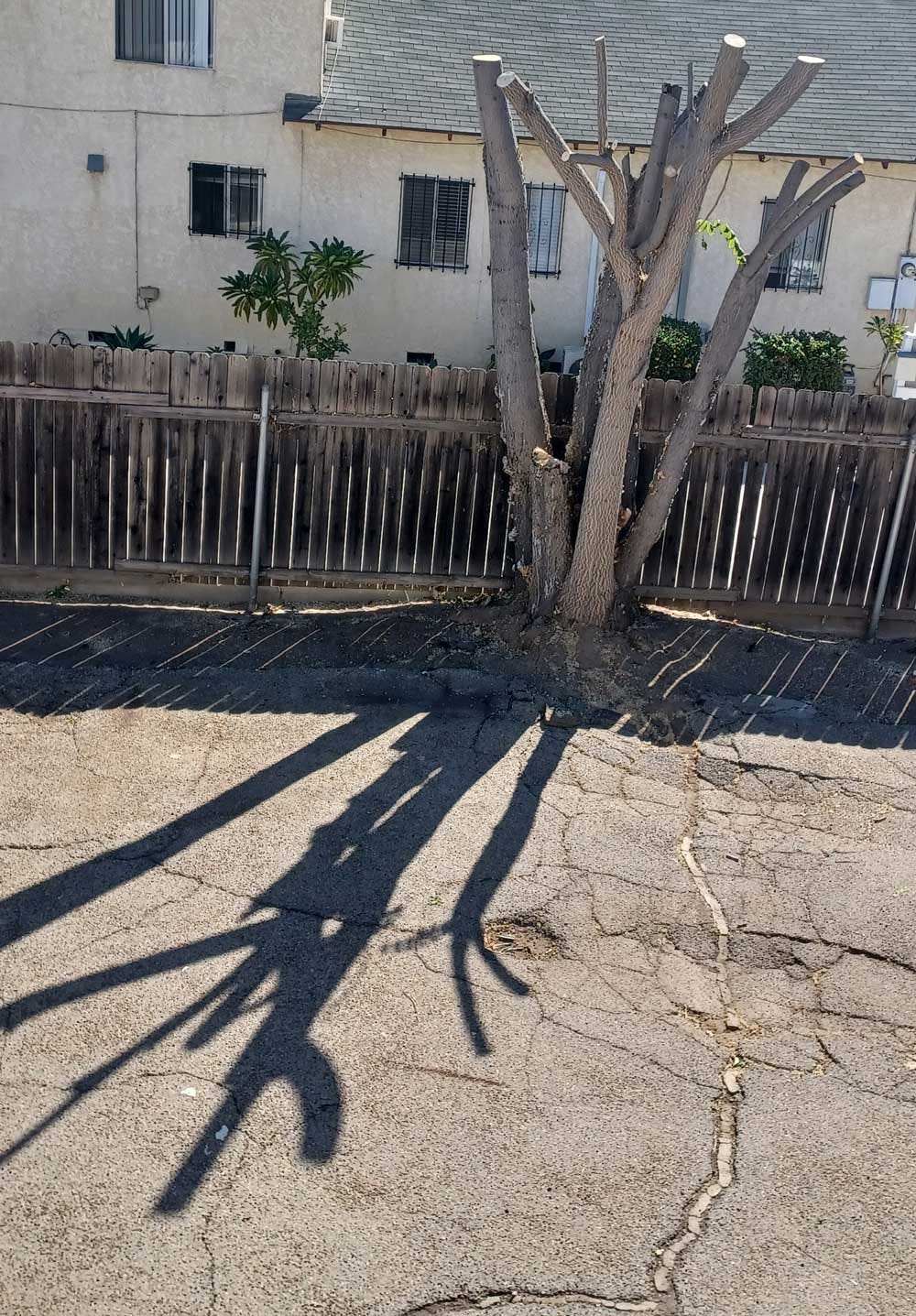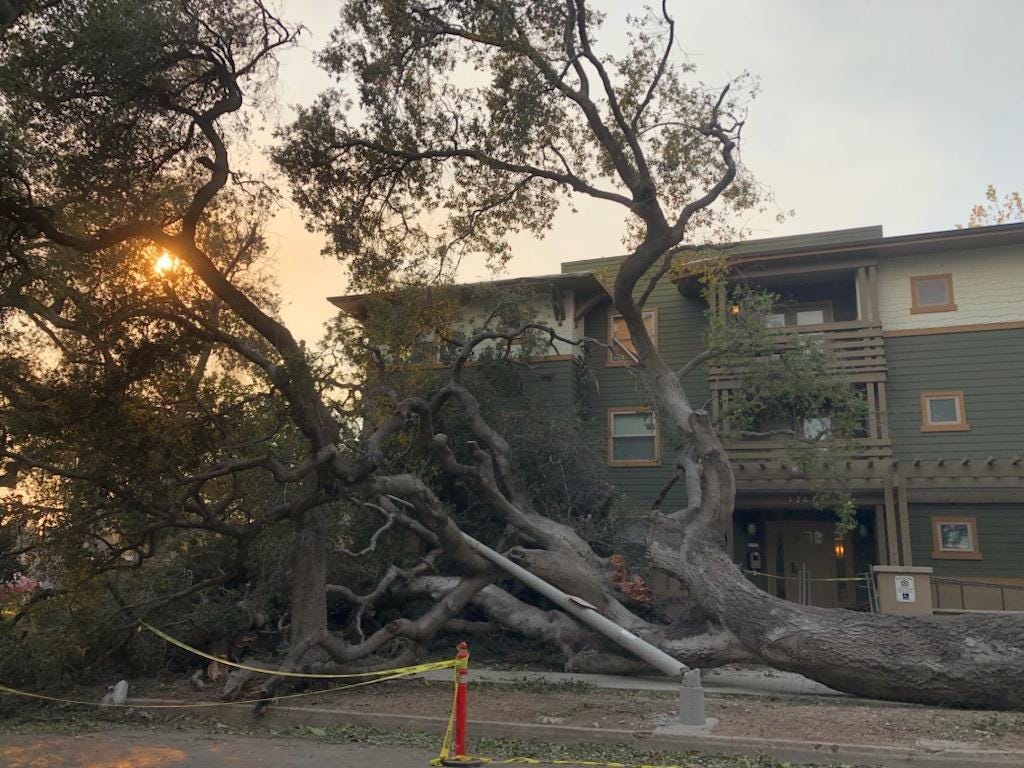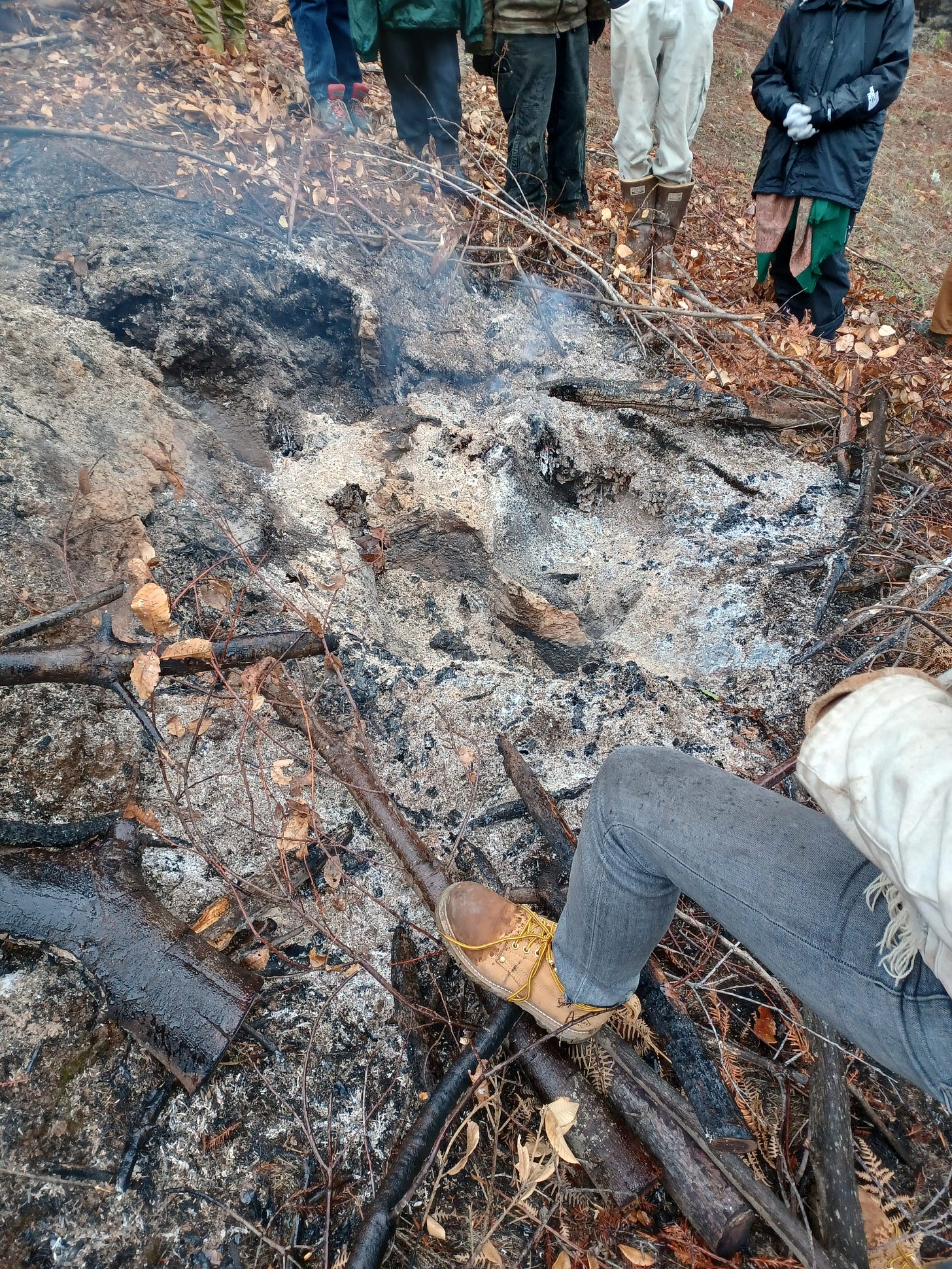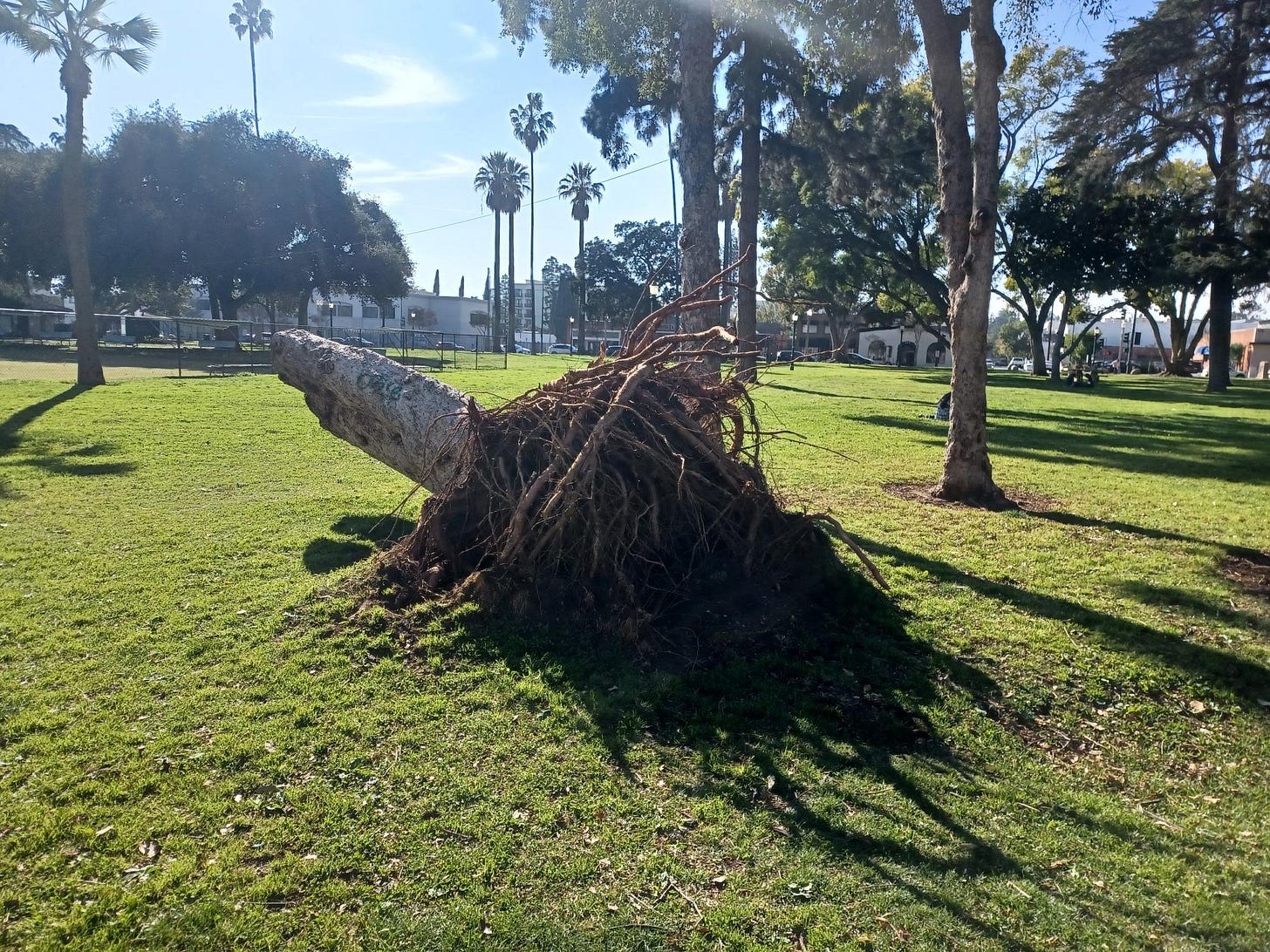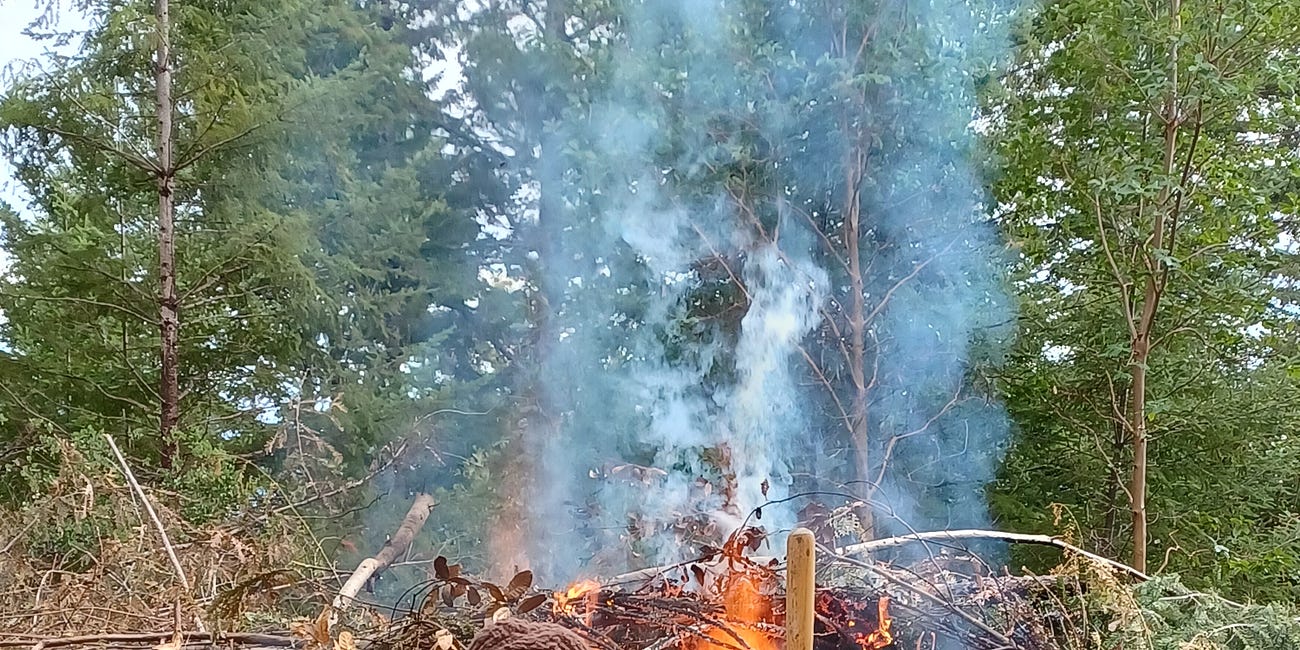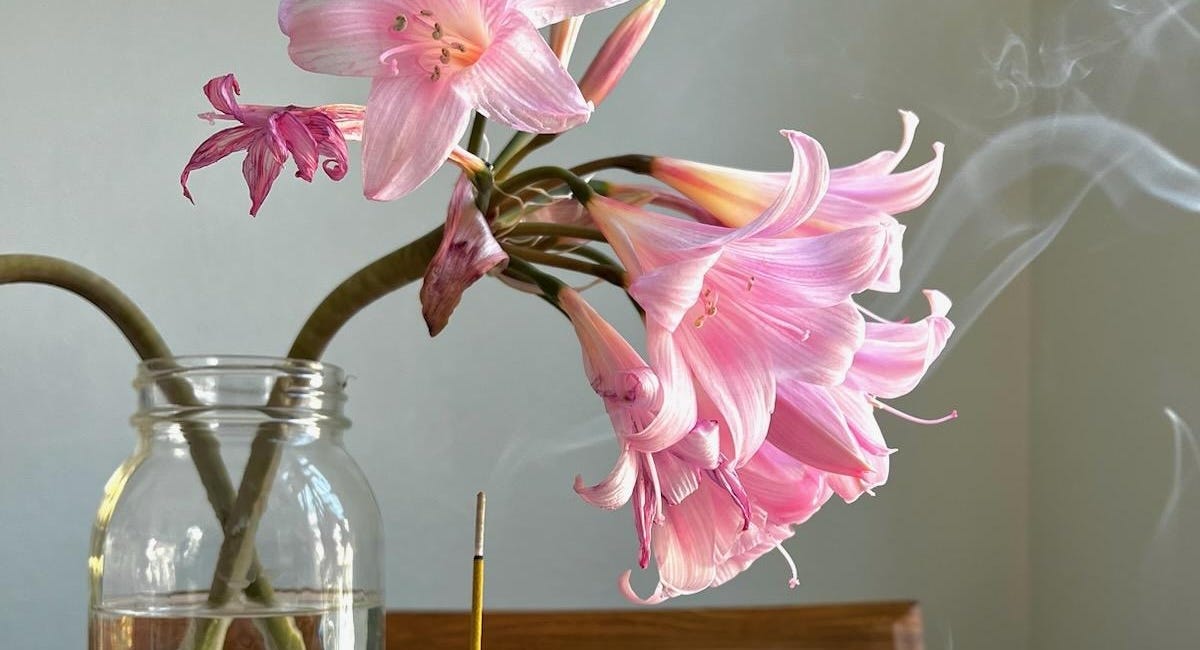Welcome to Wandering Grace. I share essays exploring the themes of displace(ment) and un(be)longing 1-2 times a month that follow the stops of my 2023 Migration Tour, and sometimes bonus snapshots from the road. Read more about the project here. See an archived list of essays in-order here.
Last month, a reflection on the ways our soft animal bodies need each other in these frightful times and a bonus list of reads that help orient us to change during these ‘Tower’ moments. Today, further reflections about grief in the aftermath of the LA wildfires.
Please consider upgrading to a paid subscription to support this writing, this work, and me!
The back of my small apartment complex is an expanse of concrete, broken-up and unused space. A few trees line the backfence and provide greenery that blocked sun and streetnoise, provided shelter for birds and stray cats and any number of creatures I don’t normally think of on a day-to-day basis.
An autumn storm knocks out a large fork of the tree, and the fallen branches block our back stairs for awhile. The landlady (who lives in another city) eventually calls in landscapers to deal with the trees.
As I watch them work throughout the day, I hold out naïve hope that they are here to clean up, and then that they are here just to give the trees a good trimming, that there may be enough left for the branches and leaves to regrow.
I am gutted when I realize they are there to clear-cut not only the fallen tree down to stumps, but also its neighbors all along the fence.
We are left with gray nakedness.
The November 2024 U.S. presidential election happens the following week. I am uncertain where exactly my low-blue mood stems from, but maybe it doesn’t matter.
Months later, when the January 2025 LA fires sweep through our area, I feel a fleeting moment of gratitude that our backyard trees aren’t at risk of causing further damage during the night of the Santa Ana windstorms, but I am not done grieving the trees themselves.
I’ve been grieving those trees for months.
In the weeks after the fire, I find myself drawn to the sites of more fallen trees. The remnants after the clean-up crews haul away the piles of branches and palm leaves and ash that lined the sides of the roads for awhile there. I visit the uprooted stumps to take photos and document them.
I marvel at the ways our lawn and sidewalk are torn up by their mighty roots. I marvel at the expanse of soil hidden underneath our manmade infrastructure of flatness and concrete. The teeming of life revealed in an old one’s death.
It is only now that I am writing this that I realize…what I really wanted was to lay my hand on their trunks, and to be with them in the aftermath.
I haven’t been brave enough to visit the burn scars of the Eaton Canyon fire or the burned-out parts of the Altadena neighborhood. I’m not even sure we can yet, what roads or pathways remain blocked, what manmade toxins affect our relationship with those neighborhoods and lands now. But I want to. I want to go.
To see it. To register it. To feel it.
There are voices that I follow who have been pointing out our need to grieve, the consequences of our unprocessed grief, and our underdeveloped capacities for grieving as modern-day humans. Malkia Devich-Cyril in conversation with adrienne maree brown. Prentis Hemphill in conversation about neurology & somatic healing. Sarah Jaffe in conversation with Kelly Hayes.
We need to be able to grieve, and we need to be able to grieve collectively.1
I remember the same pull to the fallen trees on my sidewalk walks around South Pasadena a decade ago, during my grief sabbatical in 2011, after that season’s Santa Ana winds.
During my experience at Bellweather in Northern California where we received some introductory training in prescribed burns and fire ritual, we revisited the sites of our burns as a group the following day as a form of aftercare and witness. The aftercare was as necessary for us as it was for the land.
To be in relation. To mark time. To offer and receive care.
In conversation, I find myself nodding to the fact that we still need to — as a society and as a country — make sense of and grieve the shockwave of the 2020 (and ongoing) coronavirus pandemic. But then I read this essay in Leah Lakshmi Piepzna-Samarasinha’s book The Future is Disabled about chronic grief, and realized that I was doing the pattern where: I hold my breath and put my emotions aside until the crisis passes, because I believe I need a certain amount of space and time to process something, so I wait and wait and wait until there is time to give it its due. I mistakenly believe that we can grieve it once and be done. I forget the nonlinearity and ongoingness and entanglements of grief.2
“Pandemic grief is more of a chronic illness than a short-term virus. And chronically ill strategies of managing and living within chronic illness are going to go a long way towards helping us living within this pandemic, anthropocene grief.”
“Crips know. When you first go down with your chronic illness, many people around you will tell you they hope you ‘feel better soon.’ When you never ‘get better’ — when this is your chronically ill life — you have to learn new strategies in how to live it. It’s common in sicko communities for people to talk about learning pacing…
“I saw similar skills in grief stewardship in COVID. I had days and weeks of acute grief, where I wept for seven hours on my couch, where everything was overwhelming…Yet, I also have days and weeks where grief is a more everyday presence. The tears that spring up are not an emergency, but a regular visitor.”
~ Leah Lakshmi Piepzna-Samarasinha, “Disabled Grief Technologies: Disability Justice Future-Building in a Time of Mass Grief”, The Future is Disabled
The January 2025 fires in LA came on the heels of Hurricane Helene in NC in 2024, and it won’t be long before more brutal winter storms cause some other disaster in some other part of the States (let alone the level of news on the world stage).
Growing up, there was time to catch your breath between natural disasters. As climate change intensifies, as multiple pandemics rage, as the American political slide towards fascism wreaks havoc on our most vulnerable communities, there will be less time between disasters…but that doesn’t mean there will be any less grief. I know I/we can’t “wait until it calms down” in order to feel these things. We have to be able to weave in the dancing and the joy and the grief and the rage where we can, into the fabric of our daily lives, and into the fabric of our community weaving.
There is no right time. There is only the time we need.
To wonder. To cry. To be with. To tend.
Queers in Palestine call on us to continue to: “Rage and grieve as radical forces for change.”
For me, it starts with following my pull: to sites where I can acknowledge reality, to places where I can re-associate and re-orient to our here and now, so that grief can move through me (and us) if it wants to.
Right now, what I know is I want to be with the trees, and the fallen trees.
BONUS: Fire photos from Bellweather
The first time I visited this land was in December 2022 for “a week-long immersive training guided by right relationship with fire, fellowship, and making space for miraculous attention”. Participants received some training and experience with prescribed burns, within a container of sacred ritual and right relationship. It was a transformative experience. Here are some photos from the Dec ‘22 trip on this land as memory, archive, and background context for my May '23 trip.
Thresholds and Webs as Maps
I wrote about the 20th anniversary of my mom's death and inviting others in via incense and ritual to mark the occasion.
Ironically, when you put an emotion that arises, aside instead of feeling it in the moment, it often grows to become more overwhelming than if you had just felt what you needed to feel when the feeling wants you to feel it. I wrote a whole graphic novella about this called It’s Okay That It’s Not Okay. Read it online, or order a physical copy from me or from Radiator Comics.




